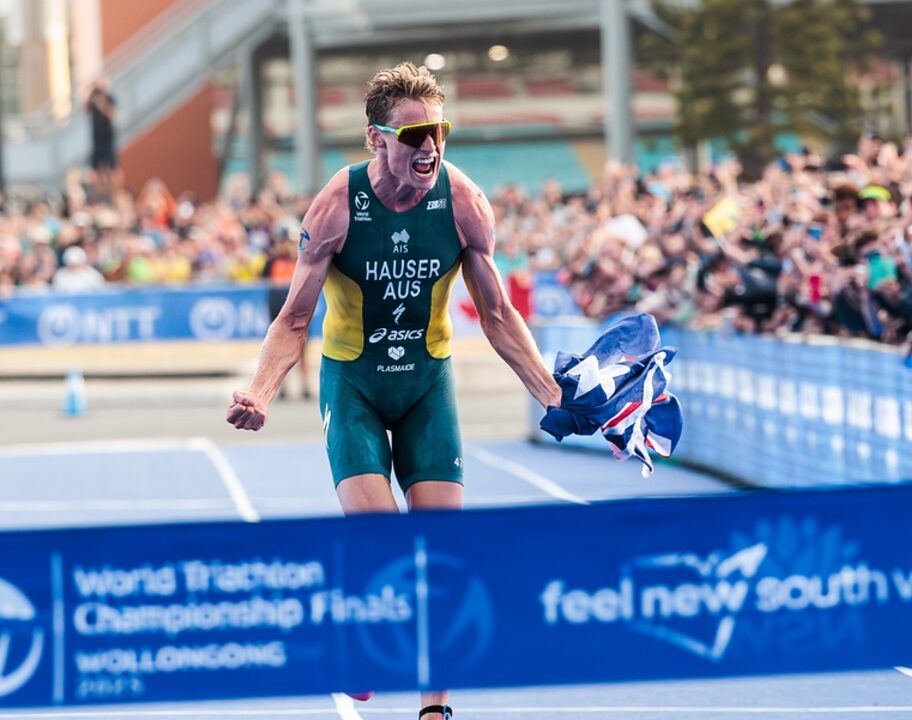From relentless head winds that make it feel like you’re pedalling squares. To gusty cross winds that try to push you and your trusty two-wheeled steed across the road. Cycling in windy conditions can be frustrating, annoying – and sometimes even a little bit scary. Whether you’re heading out on a training ride, or dealing with windy conditions on race day at your next triathlon event. We share some top tips to help you feel more confident while riding your bike in the wind.
- Should I swap out my deep aero rims for narrow rims when riding in the wind?
- Check the wind direction when planning a cycling route
- Don’t obsess over your average pace while cycling in the wind
- Think about your body position on the bike
- How to handle your bike in cross winds
- Dealing with windy conditions on race day – dos and don’ts
Should I swap out my deep aero rims for narrow rims when riding in the wind?
Whether it’s a training ride or race day, if you’re lucky enough to have more than one set of bike wheels to choose from – you might be wondering whether you should switch to narrower rims while riding in windy conditions. Deeper rims and/or a disc wheel on the rear will give you the best aerodynamic performance. But if you’re worried about how your bike will handle in the cross winds you might be thinking about switching your aero wheelset out for shallower rims on front and back.
However, we spoke to the experts from Parcours and they revealed that a deeper rear wheel can actually improve stability in windy conditions.

Of course, a deeper section front wheel will increase the sideways force of a cross wind. But if you decide to use a narrower rim on the front, it’s worth thinking about sticking with a deeper rear wheel (or running your disc wheel in a race) on the back. This will give you the aerodynamic benefit – whether you’re racing for podium positions or just trying to nab a Strava segment. And it could actually help with stability in blustery conditions.
Check the wind direction when planning a cycling route
If you’re heading out on a training ride, take a look at the wind direction when you’re planning your route. Ideally you want to get the worst of the riding into the head wind over and done with at the start of the ride while you’re feeling fresh. Nothing feels more soul destroying than turning around for home after a couple of hours of riding only to discover you’ve got a relentless head wind to battle against, when you’re already feeling fatigued. If the wind is particularly strong, consider breaking your ride down into several shorter laps so you’re going to get regular respite from strong head- and cross winds.
Look at the wind forecast on race morning
While you can’t go and demand the race director changes the bike route so you’ve got more tail wind than head wind, it’s still worth knowing what direction the wind will be blowing during a race.
On race morning before you head to transition to do your final pre-race checks, take a second to have a quick look at the weather forecast for the time you’ll be out on the bike and take note of the wind direction compared to the course.
It’s helpful to know where and when you can expect to have a head wind so you can be mentally prepared for it. And it’s also good to know if there are any sections of the course where you’re likely to have strong cross winds so you don’t get taken by surprise by any strong sideways gusts.
Don’t obsess over your average pace while cycling in the wind
Average pace becomes an unreliable narrator when you’re riding in windy conditions. You’ll be going significantly slower for the same effort while you’re riding into the head wind. And once you get a tail wind, you’ll be getting a major helping hand. Save your sanity and just ignore your average pace when you’re riding in windy conditions.
You’re far better off using data points such as power or heart rate (ideally both) to manage your effort. This is particularly applicable during racing, where you don’t want to spend half the bike leg completely cooking your legs as you battle against the head wind. But it’s just as important for training rides to make sure you’re riding at the prescribed intensity to get the optimal training effect from the ride or workout. Take a look at our guide to triathlon training zones and our threshold explainer to find out more about how to pace yourself on the bike.
Think about your body position on the bike
The reason that riding into a head wind feels so much more difficult is because the strong force of the wind creates more resistance for you to work against to make forward progress. And the larger the frontal surface area presented to the wind, the greater the air resistance is going to be. This is why aerodynamics are such a buzz topic in cycling – the more aerodynamic you are (i.e. the lower your CdA) the easier it is to overcome wind resistance.

And while we’ll get onto the aero gear you can use to reduce the impact of the wind. It’s important to remember that the biggest cause of drag while you’re riding, is you. So first up think about your riding position when you’re out there battling the head winds. Are you staying low on the drops (or TT bars)? It can be tempting to sit up in a head wind so you can push bigger watts – but you’re actually making it harder for yourself. Focus on tucking down into as aerodynamic position as possible, keeping your head low (but don’t look down – eyes on the road!) and your shoulders squeezed to minimise the amount of drag your body creates against the wind. Resist the temptation to grind a big gear, too. You’ll just fatigue your legs faster. Instead, shift down into an easier gear and focus on maintaining an efficient cadence.
How to handle your bike in cross winds
Head wind can feel a bit soul destroying. But the cross winds can actually be the trickier foe to fight – forcing you sideways across the road or making your front wheel feel unstable. Riding in a cross wind can be quite scary, particularly for nervous riders. However there are some tips and tricks to make riding in a cross wind feel a bit more comfortable.
When you’re out on a training ride, anticipate where you might get a sudden blast of cross wind by looking out for gaps in hedge rows or fences – often it’s being caught by surprise that makes those sideways gusts feel far scarier.
If you find yourself being blown sideways across the road, stay calm, stay relaxed and trust your bike. Tensing up will only increase how ‘twitchy’ the bike feels, and sudden movements/pulling the brakes are the things that are going to increase the likelihood of coming off. Keep both hands on the handlebars, but keep any turns relaxed and lean slightly into the wind to counter the sideways force.
In a race situation, as recommended by our Kona insiders, look ahead to other riders up the road and see when they’re being moved sideways to anticipate where you might get a gust of cross wind.
Dealing with windy conditions on race day – dos and don’ts
High winds during the bike leg of a triathlon can be frustrating – especially if you’ve got a target bike split time in mind. But there’s plenty you can do to reduce the impact of the wind on your bike split, without destroying your legs for the run.
Aero is everything – optimise your gear
Being able to ride faster in a head wind is all about reducing your CdA. The gear you choose and your bike set up can have a big impact on the amount of drag you create, and therefore the amount of resistance you face riding into a head wind.
Race kit
An aerodynamic tri suit can actually save you a surprising amount of time in windy conditions. And as we discovered when we tested out the BodyRocket aero system – a full aero time trial helmet also saves a significant amount of time, particularly over longer distances, even compared to an aero road helmet.

To really up the ante on the marginal aero gains front, you could also consider wearing calf sleeves/calf guards. You can wear these under your wetsuit (assuming your race has a wetsuit-legal swim) so you won’t lose any additional time in transition putting them on. And while the watt saving claims vary by brand, it can be up to 12 watts which is significant in long distance racing. You can even get aero race number belts – such as the NoPinz belts – which eliminate flappy paper race numbers which can slow you down.
Bike set up
We’ve already talked about wheels – with the bottom line from the experts being that an aero rear wheel (or even a disc wheel) can actually improve stability in the wind, rather than hamper it. The other consideration is making sure your bike is set up with TT bars so you can get into an aerodynamic position. Just make sure you do plenty of training in your TT position so you can hold it during your race!
Don’t attack the head wind like it’s a hill – stick to your race plan
Hills have a definitive beginning and end. Head wind doesn’t. While it might be tempting to start grinding out the power to fight against the head wind, you’ll end up doing more harm than good. You could be working at an unsustainable effort for longer than you think, which will come back to bite you later in the race. The head wind could be even stronger on the second lap, and you’ve already spent too much energy fighting it the first time around. And don’t forget – the wind direction can change so you might get an unexpected blast of head wind elsewhere on the course.
Stick to your race plan and maintain a sensible, manageable effort keeping in mind you’ve got still got a long day of racing ahead of you. You’ll be in a better place to make up the time later in the race if you don’t overcook it on the bike.
Don’t lose your head: mindset matters
Riding into a head wind can be physically draining. But it’s also mentally tough. Try to keep a positive mindset and avoid getting angry or frustrated if you can’t hit the pace you were aiming for due to the conditions. It won’t change the situation, and it’ll just use up vital mental energy that you’ll want to have in reserve to tap into later on in the race when things get tough towards the end of the run.
Try to focus on what you can control. You can’t switch the head wind off. But you can make sure you’re getting your nutrition and hydration on board. You can focus on holding a good aerodynamic position. And you can keep your effort steady and controlled so you have enough fire power left for the latter stages of the race. The conditions are the same for everyone, and it’s those who can keep a positive mindset who’ll come out on top! Plus, at some stage you’re going to get an amazing tail wind to compensate for all that grind – look forward to it!
Head to our bike training section for more triathlon cycling tips, and don’t forget to check out our round up of the best tri suits if you’re looking to up your aero kit game!











